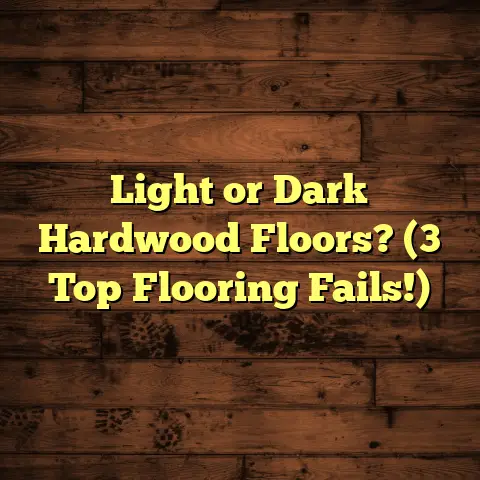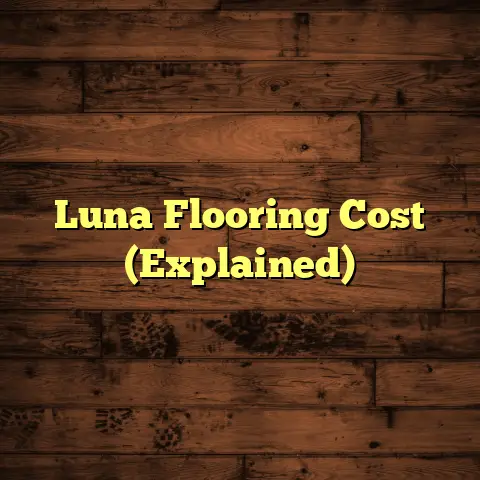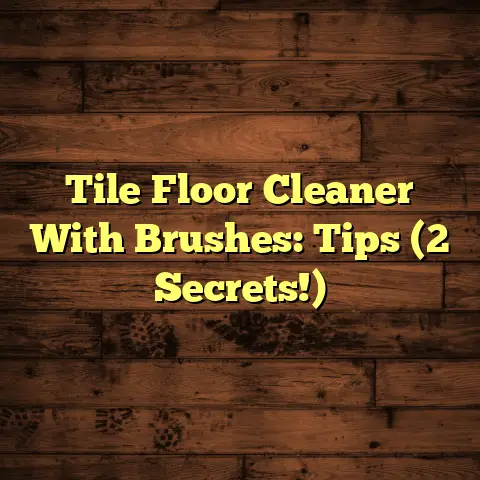How Much Bleach is Safe to Clean Floors? (2x Dilution!)
I’ve seen it all when it comes to floors – the good, the bad, and the downright ugly.
And let me tell you, one thing I’ve learned is that proper cleaning is absolutely crucial.
Today, I want to talk about something near and dear to my heart (and your floors!):
Cleaning with bleach, specifically when it comes to a 2x dilution.
But first, let’s chat about something a little special…
Bamboo Flooring: A Sustainable Choice
In recent years, I’ve noticed a huge surge in the popularity of bamboo flooring.
And honestly, I get it!
It’s eco-friendly, durable, and has a really unique aesthetic appeal.
Think of it as hardwood’s cool, sustainable cousin.
Bamboo is made from a rapidly renewable resource, making it a green choice.
It’s also surprisingly strong, often rivaling traditional hardwoods.
Plus, it’s naturally resistant to moisture and insects.
That makes it a winner for kitchens, bathrooms, and even basements.
But here’s the thing: even though bamboo is tough, it still needs proper care.
That’s where understanding cleaning solutions – especially bleach – becomes vital.
We need to keep it looking its best without causing damage.
So, let’s dive into the world of bleach and how to use it safely on your floors!
Section 1: Understanding Bleach
What exactly is bleach?
Simply put, it’s a chemical solution used for cleaning, disinfecting, and whitening.
You’ll find it in everything from laundry detergents to household cleaners.
Chemically speaking, most household bleach is a solution of sodium hypochlorite (NaClO) in water.
It’s the active ingredient that does all the heavy lifting.
Now, you might be wondering, “Are all bleaches the same?”
Nope! You’ve got a few different types out there:
-
Regular Bleach: This is your standard sodium hypochlorite bleach. It’s powerful and effective, but can be harsh on some surfaces.
-
Color-Safe Bleach: Usually contains hydrogen peroxide or other oxygen-based bleaching agents.
It’s gentler than regular bleach, but may not be as effective for tough stains.
-
Oxygen Bleach: Often in powder form, this releases oxygen to lift stains and brighten surfaces.
It’s considered more environmentally friendly than chlorine bleach.
Regardless of the type, dilution is key when using bleach for cleaning.
Why? Because concentrated bleach can be incredibly corrosive and damaging.
Think about it: you wouldn’t drink straight lemon juice, right?
You’d dilute it with water to make lemonade.
Same principle applies here!
Dilution reduces the concentration of the bleach, making it safer to use.
It still allows it to clean and disinfect effectively.
Section 2: The Science of Dilution
Okay, let’s get a little scientific for a minute.
Dilution is simply the process of reducing the concentration of a solute (like bleach) in a solution by adding more solvent (like water).
In simpler terms, you’re making the bleach weaker by adding water.
So, what does “2x dilution” mean?
It means you’re mixing one part bleach with one part water.
That’s a 1:1 ratio.
For example, if you’re using 1 cup of bleach, you’d add 1 cup of water.
Easy peasy, right?
But why is this specific dilution important?
Well, the appropriate dilution ratio depends on a few factors:
-
Type of Flooring: Some materials are more sensitive to bleach than others.
Bamboo, for instance, can be damaged by overly strong bleach solutions.
-
Extent of Stains or Dirt: For light cleaning, a weaker solution may suffice.
For tougher stains or disinfecting, you might need a slightly stronger one.
-
Manufacturer’s Recommendations: Always check the flooring manufacturer’s guidelines for cleaning instructions.
They know their product best!
Using the wrong dilution can have serious consequences.
Too much bleach can:
-
Discolor or damage your flooring.
-
Leave behind a sticky residue.
-
Release harmful fumes.
Too little bleach may not be effective in killing germs or removing stains.
It’s a balancing act!
According to the CDC, a general disinfectant solution can be made with 5 tablespoons (1/3 cup) of unscented liquid chlorine bleach to 1 gallon of water.
This isn’t the 2x dilution we are discussing, but it shows a range of dilution.
Section 3: Safe Practices for Using Bleach on Floors
Alright, let’s get practical. How do you safely clean your floors with diluted bleach?
Here’s a step-by-step guide I always recommend to my clients:
-
Gather Your Supplies: You’ll need bleach, water, a bucket, gloves, a mask, and a mop or sponge.
-
Protect Yourself: Put on those gloves and mask!
Bleach can irritate your skin and lungs, so protection is key.
-
Ventilate the Area: Open windows and doors to ensure proper ventilation.
You don’t want to be breathing in those fumes.
-
Mix the Solution: In your bucket, carefully mix one part bleach with one part water (2x dilution).
Always add bleach to water, never the other way around.
This helps prevent splashing and minimizes the risk of a chemical reaction.
-
Test in an Inconspicuous Area: Before you go wild on your entire floor, test the solution on a small, hidden area.
This will help you see if the bleach is going to damage or discolor your flooring.
Wait at least 24 hours to check for any adverse effects.
-
Mop or Wipe the Floor: Dip your mop or sponge into the diluted bleach solution and wring out any excess liquid.
You want the floor to be damp, not soaking wet.
-
Rinse Thoroughly: After cleaning with bleach, rinse the floor thoroughly with clean water.
This will remove any remaining bleach residue.
-
Dry the Floor: Use a clean, dry towel or mop to dry the floor.
This will help prevent water spots and streaks.
For different flooring types, you might need to adjust your technique:
-
Bamboo: Use a gentle mop and avoid excessive moisture.
Too much water can warp or damage the bamboo.
-
Hardwood: Follow the grain of the wood when mopping to prevent streaking.
Make sure the mop is only slightly damp.
-
Tile: You can be a little more liberal with the bleach solution on tile, but still rinse thoroughly.
Remember, always err on the side of caution.
If you’re unsure about using bleach on your floors, consult a professional.
Section 4: The Benefits of Using Bleach for Floor Cleaning
Despite the potential risks, bleach offers some significant advantages when it comes to floor cleaning:
-
Germ-Killing Power: Bleach is a powerful disinfectant that can kill a wide range of germs and bacteria.
This is especially important in areas like kitchens and bathrooms, where germs tend to thrive.
-
Stain Removal: Bleach can effectively remove tough stains, such as mold, mildew, and food spills.
It’s particularly useful in damp areas where mold and mildew are common.
-
Brightening Effect: Bleach can help brighten dull or discolored floors, making them look cleaner and more vibrant.
In my experience, bleach cleaning is particularly beneficial in scenarios like:
-
After a Flood: To disinfect and prevent mold growth.
-
In High-Traffic Areas: To kill germs and remove dirt and grime.
-
For Pet Owners: To eliminate pet odors and disinfect accidents.
However, it’s important to weigh these benefits against the potential risks and drawbacks.
Section 5: Potential Risks and Drawbacks of Using Bleach
Let’s be real: bleach isn’t perfect.
It has some potential downsides that you need to be aware of:
-
Corrosive Nature: Bleach is a corrosive substance that can damage certain flooring materials, especially if used in high concentrations.
-
Discoloration: Bleach can discolor or fade some flooring, particularly colored or patterned surfaces.
-
Health Risks: Exposure to bleach can cause respiratory irritation, skin burns, and eye damage.
It’s crucial to use bleach in a well-ventilated area and wear protective gear.
-
Environmental Impact: Bleach can be harmful to the environment if it’s not disposed of properly.
It can contaminate water sources and harm aquatic life.
For those who are wary of using bleach, there are several alternative cleaning solutions available:
-
Vinegar: A natural disinfectant and deodorizer.
-
Hydrogen Peroxide: A gentler bleaching agent.
-
Commercial Floor Cleaners: Formulated specifically for different flooring types.
Section 6: Comparison with Other Cleaning Agents
So, how does bleach stack up against other common cleaning agents?
Let’s take a look:
| Cleaning Agent | Effectiveness | Safety | Environmental Impact |
|---|---|---|---|
| Bleach | High | Can be corrosive, health risks | Harmful |
| Vinegar | Moderate | Generally safe | Low |
| Hydrogen Peroxide | Moderate | Generally safe, can cause mild irritation | Low |
| Commercial Cleaners | Varies | Varies, check labels | Varies |
-
Vinegar: Vinegar is a natural disinfectant and deodorizer that’s safe for most flooring types.
However, it’s not as effective as bleach at killing germs or removing tough stains.
-
Hydrogen Peroxide: Hydrogen peroxide is a gentler bleaching agent that’s less likely to damage flooring.
It’s a good option for light cleaning and stain removal, but it may not be strong enough for heavy-duty cleaning.
-
Commercial Floor Cleaners: Commercial floor cleaners are formulated specifically for different flooring types.
They can be effective at cleaning and protecting your floors, but they may contain harsh chemicals that can be harmful to your health and the environment.
When might it be more beneficial to use these alternatives instead of bleach?
-
For Everyday Cleaning: Vinegar or hydrogen peroxide are good choices for routine cleaning.
-
For Sensitive Flooring: Commercial cleaners formulated for your specific flooring type are often the safest option.
-
For Those with Respiratory Issues: Vinegar or hydrogen peroxide may be better choices to avoid respiratory irritation.
Ultimately, the best cleaning agent for your floors depends on your individual needs and preferences.
Section 7: Conclusion
Alright, we’ve covered a lot of ground today!
Let’s recap the key points about safely using bleach for cleaning floors, especially with that 2x dilution:
-
Bleach is a powerful disinfectant and stain remover, but it can also be corrosive and harmful.
-
Dilution is crucial to reduce the concentration of bleach and minimize the risk of damage.
-
A 2x dilution (one part bleach to one part water) is a good starting point, but you may need to adjust the ratio depending on your flooring type and the extent of stains or dirt.
-
Always wear protective gear, ventilate the area, and test the solution in an inconspicuous area before widespread application.
-
Rinse thoroughly after cleaning with bleach to remove any remaining residue.
-
Consider alternative cleaning solutions if you’re wary of using bleach or if you have sensitive flooring.
Ultimately, the key is to understand the properties of both the bleach and the flooring materials you’re cleaning.
By making informed decisions and following safe practices, you can keep your floors looking their best without putting your health or your home at risk.
So, go forth and clean with confidence!
And if you’re ever unsure, don’t hesitate to call a professional (like me!).
Happy cleaning!





